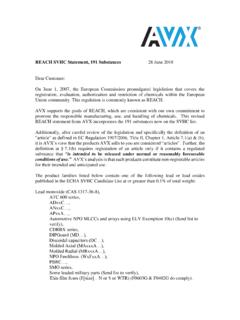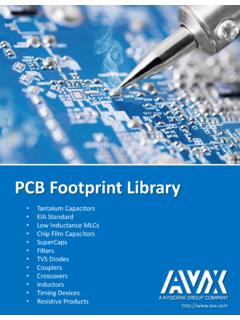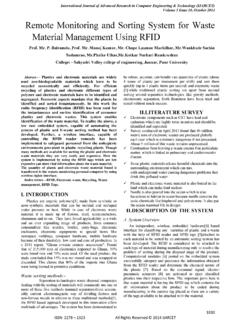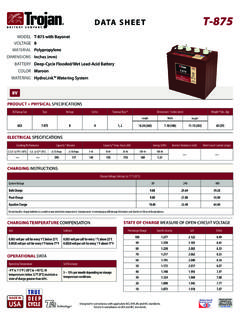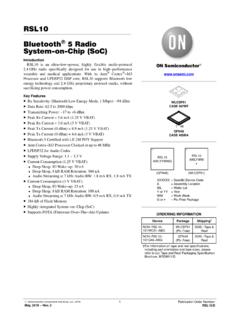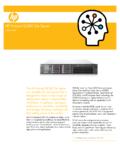Transcription of 0511 ENERGY HARVESTER PERFORMANCE final - AVX
1 Storage Capacitor Properties and Their Effect on ENERGY HARVESTER PERFORMANCE Radovan Faltus, Miroslav J n , Tom Zedn ek Technical Marketing AVX Czech Republic , Dvorakova 328, 563 01 Lanskroun, Czech Republic Phone: +420 467 558 126, Fax: +420 467 558 128. ABSTRACT. The development of ENERGY harvesters has quickened up in the last few years mainly due to semiconductor improvements. But power sources for ENERGY harvesters usually exhibit high internal impedance and can therefore only deliver low currents. The most important consideration for harvesting is that the power consumption of the controller circuitry must be less than the ENERGY generated by the power source. ENERGY harvesters use a storage capacitor slowly charged from power source through the controller and the leakage current of this capacitor is wastes a certain percentage of the generated ENERGY .
2 This paper will evaluate this effects of different technology capacitors on ENERGY HARVESTER PERFORMANCE . 1. Introduction Wireless sensor modules using ENERGY harvesters instead of a battery are often embedded in aeroplane wings for structural analysis, in car wheels to detect proper tyre pressure or in remote weather or traffic measuring units. Such devices are more convenient and efficient when powered wirelessly or self-powered. Three methods of ENERGY harvesting for this purpose are most common: inductive charging, piezoelectric and thermal. Inductive charging is an old technology, typically using transformers. However, to transfer high power a long distance between two coils there is new method called MIT Wireless Electricity.
3 This technology works by transmitting electricity as a magnetic field oscillating at a specific frequency. Through a magnetically-coupled resonance, the "receiver" can capture the electricity, making for an efficient and safe method of over-the-air transfer. The thermal ENERGY harvesting method is a lucrative approach because it is a fully self-sustainable form of DC power. Typically, a temperature differential is applied across a Peltier cell power source. Piezoelectric ENERGY harvesting was developed using a piezoelectric element and modern HARVESTER controller/voltage converter. This method is getting more popular because the PERFORMANCE of piezo generators has been boosted and low power consumption semiconductor controllers have emerged.
4 In order to evaluate the suitability of different technologies to fulfill the storage function in a piezoelectric ENERGY HARVESTER circuit, the following modern-technology parts were chosen: Tantalum-Polymer - good capacitance/ESR PERFORMANCE ;. Niobium-Oxide - high reliability/robustness;. Tantalum-MnO2 - standard and low ESR types representing good volumetric efficiency and long life;. Professional Tantalum-MnO2 capacitor - increased reliability and low DCL;. Ceramic multilayer - ultra-low ESR and low DCL. 2. Piezoelectric generator Piezo principle The development of piezoelectric materials has enabled the construction of modern devices capable of generating sufficient voltages and currents for ENERGY harvesting.
5 A piezoelectric element consists of two conductors made of metal and piezoelectric material layers. In order to create a generator, typically one end of the strip element active zone is mechanically fixed and the opposite end is loaded with small metal ballast to create a mechanical resonance system. The mechanical system has tendency to vibrate at the resonant frequency even when frequency of the actuating vibrations varies and is irregular, and maximum ENERGY is produced at resonant frequency. ENERGY generated by the voltage waveform is dependent mechanical deflection of the piezo element at the specific frequency. Experimental solution Initially, a frame for the chosen piezoelectric element, PFCB-W14 (Ref.)
6 1), was constructed. The black end with output wires (Fig. 1) was mechanically fixed and the opposite end of the active zone was placed 6mm above small electromagnet mounted to the base. As the element's body is made of a magnetic alloy, a small electromagnet acts as a very good actuator, bending the piezo strip to cause an amplitude of approximately 2mm at the end of active zone. Figure 1: Experimental piezoelectric generator using PFCB-W14 element Electromagnetic inductance would act as a parasitic effect in this experiment, but in this case, as the element core body does not close any inductive loop it will not induce any voltage in the electromagnet coil, (proven by oscilloscope measurement for a fixed 0mm mechanical amplitude).
7 The electromagnet was actuated from a square wave voltage generator with adjustable frequency. The frequency was tuned in order to reach the mechanical self- resonance that exhibited the highest efficiency measured by AC peak-to-peak voltage. The highest no-load piezo element voltage Vpp = was reached at frequency fm = 28Hz, see oscillograph in Figure 2 (measured using an Agilent Infiniium oscilloscope 54830B (Ref. 4). as with all other oscillographs.). Figure 2: AC no-load output voltage of the PFCB-W14 piezo element The internal resistance of the piezoelectric element is so high that it causes significant voltage drop when the element is loaded. Figure 3 shows the oscillograph with the generated output voltage when loaded by resistor R1 = 1k.
8 The RMS voltage Vrms1 = and RMS. current Irms1 = A. Figure 3: AC output voltage of the PFCB-W14 piezo element when loaded by 1k resistor 3. ENERGY harvesting circuit Overview A modern ENERGY harvesting system consists of four main blocks (see Figure 4): 1) ENERGY source with an output current that is insufficient to use as a direct power supply -therefore harvesting is required 2) Rectifier to create DC voltage suitable for ENERGY storage 3) ENERGY storage circuit using storage capacitor 4) DC/DC buck converter to transform the storage voltage to the required output voltage An ENERGY generator behaves as a current source with a high internal resistance. It charges an ENERGY storage capacitor driven through a rectifier.
9 The storage capacitor voltage is measured using an under-voltage lockout circuit which enables the function of the output DC/DC. converter when the stored ENERGY is sufficient for converting to the output; conversely, it blocks the function of the output DC/DC converter when the stored ENERGY is not sufficient for conversion. Thus we can recognize two main phases in ENERGY HARVESTER functionality: Charging/Output power-off and Output power-on. Figure 4: Principle of the ENERGY harvesting system Experimental solution Figure 5 shows the actual measuring circuit using evaluation kit DC1459B-A (Ref. 3), specially dedicated for piezoelectric ENERGY harvesting with DC/DC converter LTC3588-1. (Ref. 2). The output voltage was set to to feed an output load consisting of series resistor RL = 2k and red LED with threshold voltage Vt = The series resistor was selected specifically to gain a resulting pulse ratio (Charging phase/LED-On phase) of approximately 1:1 (see Figure 6).
10 Figure 5: Schematic of the actual measuring circuit using evaluation kit DC1459B-A. Figure 6: Output voltage and Storage capacitor voltage showing Charging phase and LED-On phase. NOTE: 0V indicators ( 1', 2'). The output voltage changed values between (LED threshold voltage LED off) and when the LED was emitting light driven by current ILOn = 150 A. The storage capacitor voltage changed between 4V (fully charged, ready to switch power to output) and 3V (LED. goes off). 4. Storage capacitors benchmarked The capacitors selected for the benchmark were chosen to represent different technologies exhibiting different levels of leakage current (DCL) and Equivalent Series Resistance (ESR). The leakage current of the capacitors was measured for steady state at corresponding to their voltage working range and the ESR was measured at fc = 100Hz, close to the piezo- generator frequency fm = 28Hz.



